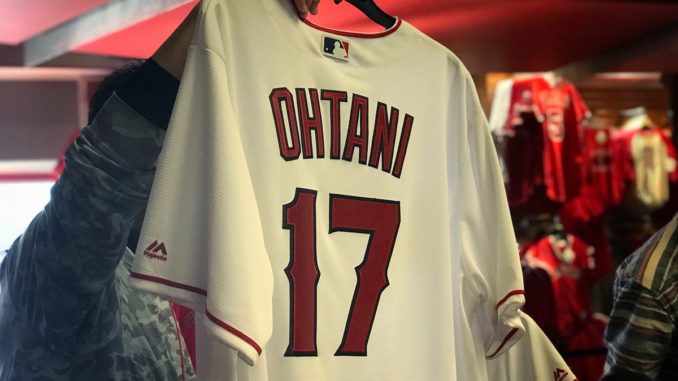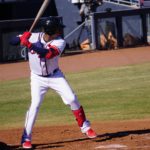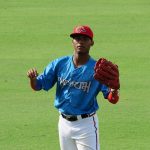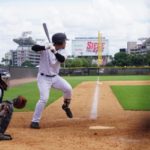
By now, you’ve heard the news, read the hype, and wondered amongst yourselves just what we can expect from two-way phenom Shohei Ohtani. After signing a minor league contract with the Los Angeles Angels of Anaheim, he joins a lineup with Mike Trout, Justin Upton, and Albert Pujols, providing LA with a much needed left-handed power bat to bring balance to a right-handed heavy line-up.
Is the hype real?
Short answer, YES! And this is not only because of Ohtani’s unique talent but also his unique contract. Ohtani chose to come to the states two years early, subjecting his talents to international bonus pool money usually reserved for Latin American teenagers that are years away from the big leagues. If he had waited two years and come over as a free agent that could demand a 10 year, $200 million contract, would GMs line up to let him play both ways and risk injuries? Would a playoff team invest that much and allow Ohtani to roam LF when not pitching? My gut says no and the evidence backs me up. Look at how starting pitchers are treated now compared to 30 years ago. Pitch limits, inning restrictions, 5-6 man rotations, and decreased bullpens are the new norm when dealing with pitchers. In an effort to protect the investment, teams have sought all sorts of creative ways to limit the amount that investment is used. As a licensed PTA working in a pediatric sports setting, I could write a book on why this overprotection of pitchers has actually led to more injuries, but that’s a different article for a different time. But the point remains, Ohtani choosing to come over two years early to sign a minor league contract and possibly play his first three seasons at league minimum, lessens the perceived risk of losing the return on investment. It also allows Ohtani a chance to realize his dream of becoming the first true two-way player since 1924.
Since 1924?!
Ohtani is seeking to become only the fifth player since 1924 to start at least 15 games on the mound and 15 games in the field in a single season. Babe Ruth accomplished the feat in back to back seasons in 1918 and 1919. How will this translate nearly 100 years later in today’s game of pitch counts and specialization? We need to take a look at how Nippon used Ohtani for the possible blueprint of how the Angels will use him.
Ohtani pitched once per week in Japan and made three starts as a hitter. His career high in starts is 24 in 2014 with a high of 160.2 IP in 2015. It warrants mentioning that an ankle injury limited him to 25 IP last season, so it is likely that he will top out at 175-180 IP. If he can reach those numbers, he should be a top 15 fantasy starting pitcher based on hs arsenal and track record. In 2015, Ohtani posted a ridiculous 11.01 K/9. In the strike-out happy world of MLB, Ohtani’s K/9 should translate well, making 220 K’s a realistic number. In comparison, Yu Darvish pitched 191.1 IP his first year with Texas and struck out 220. However, Darvish threw over 1,000 innings in Japan to Ohtani’s 543 and the relative inexperience could skew some of Ohtani’s numbers the wrong way. Let’s take a closer look at the age-related seasons of Yu Darvish and Masahiro Tanaka for a comparison.
Yu Darvish posted five straight seasons of an ERA under 2.00. His best season of 1.44 at age 24 was his final season in Japan. His career high in walks was 64, during his age 19 season. In his first year in Texas, Darvish posted 3.90 ERA, 3.29 FIP but walked 89 hitters, leading to a career high 1.280 WHIP. Coincidentally, this is what he posted during that age 19 season. Masahiro Tanaka was even better than Darvish in Japan. In his final three seasons in Japan he posted a 1.27, 1.87, and 1.27 ERA. Unlike Darvish, Tanaka did not experience an abnormal bump in BB/9 but his ERA did rise to 2.77 during his rookie season, and his career ERA is currently 3.56.
So, let’s assume that Ohtani stays healthy and is able to make enough starts to reach 175 IP. His K rate should translate, but MLB hitters are too good to not make adjustments. I project we will see an increase in BB/9 and WHIP that will lead to an ERA between 3.50 and 3.85. However, pitching in Anaheim, a pitcher’s park, with Andrelton Simmons and Mike Trout behind him, Ohtani could reach low 3’s in ERA and even sub 3.
Ohtani the hitter
Ohtani was in the lineup as a hitter three games per week. Assuming he hits for himself on the mound, we are looking at approximately 16 at bats per week. That would give him 384 at bats. In 2016, Ohtani hit 22 HR in 323 at bats, good for a HR every 14.68 AB. On the other hand, Hideki Matsui hit 38 HR in 487 AB during his age 22 season giving him a 12.86 HR/AB rate. Matsui, however, did not come stateside until he was in the midst of his prime at age 29. More telling though is Matsui’s K rate. He drew more walks and struck out less than Ohtani during their age 19-23 seasons. Ohtani has a career 10% BB rate and 27% K rate which could lead to periods of struggle at the plate. Ohtani is much more polished on the mound, so I expect him to struggle to reproduce his success at the plate. A slash line of .270/.330/.480 with close to 100 strikeouts is a likely outcome. I do think pitchers will challenge him, especially if he hits in a favorable spot in the line-up either ahead of or behind Mike Trout. If pitchers do challenge him, 25 home runs is not out of the question.
So where does he fit on my fantasy lineup?
I have heard a number of different scenarios on how the different fantasy sites will accumulate his stats. Will they create 2 Ohtanis, a hitter and a pitcher? Will they give him multi position eligibility with the caveat that if he is pitching that his hitting stats will not count for that day? Or will developers and code writers give us what we want and have all his stats count? The second scenario would certainly decrease his fantasy value in weekly leagues. Fantasy GMs should consider that before taking him ahead of the top 10 starting pitchers.
I expect, depending on your league, that Ohtani will have an ADP in the 80’s. His biggest value will come on the mound where he will flirt with 200 strikeouts, even if he is in a six man rotation. The 25 HR would make him a solid 2nd or 3rd OF or top UT guy. In dynasty leagues deeper than 16 teams that use real life contracts, that type of value from one guy should make him one of the top targets in any draft.
More importantly, even if Ohtani is merely league average on the mound and at the plate, he could open the door for more two way players, and change the way teams evaluate amateurs. This could lead to a cultural shift in front offices that should not be underscored.
Let the hype train begin!
And don’t forget: Shohei Ohtani will be hitting bombs in a ballpark near you. pic.twitter.com/WXmkNDyZIH
— Max Wildstein (@MaxWildstein) December 1, 2017
Shohei Ohtani is getting posted by his Japanese club today. Ohtani will be someone you’ll have to watch play. pic.twitter.com/yPM50y7k9z
— Max Wildstein (@MaxWildstein) December 1, 2017
Article featured image – courtesy of @Angels Twitter
Spotted at The Angels Team Store 👀 #ShoheiDay pic.twitter.com/YndASxFaT7
— Angels (@Angels) December 9, 2017
Jason Woodell has written about prospects for numerous sites. He got his start with Prospects1500 and has provided reports on prospects for Baseball Prospectus, 2080 Baseball, and Pinstriped Prospects. Jason is a licensed Physical Therapist Assistant and former model in Jordan. He lives in Tampa, likes dogs, craft beer, and his wife…not necessarily in that order.
Follow him on Twitter @JasonAtTheGame.





Leave a Reply